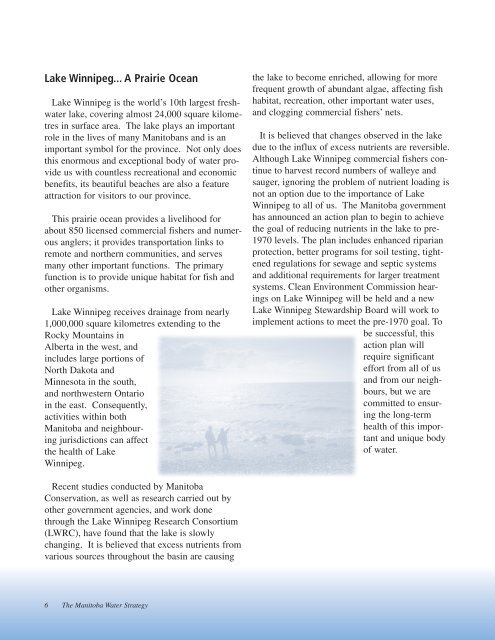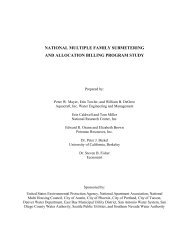The Manitoba Water Strategy - Government of Manitoba
The Manitoba Water Strategy - Government of Manitoba
The Manitoba Water Strategy - Government of Manitoba
You also want an ePaper? Increase the reach of your titles
YUMPU automatically turns print PDFs into web optimized ePapers that Google loves.
Lake Winnipeg... A Prairie Ocean<br />
Lake Winnipeg is the world’s 10th largest freshwater<br />
lake, covering almost 24,000 square kilometres<br />
in surface area. <strong>The</strong> lake plays an important<br />
role in the lives <strong>of</strong> many <strong>Manitoba</strong>ns and is an<br />
important symbol for the province. Not only does<br />
this enormous and exceptional body <strong>of</strong> water provide<br />
us with countless recreational and economic<br />
benefits, its beautiful beaches are also a feature<br />
attraction for visitors to our province.<br />
This prairie ocean provides a livelihood for<br />
about 850 licensed commercial fishers and numerous<br />
anglers; it provides transportation links to<br />
remote and northern communities, and serves<br />
many other important functions. <strong>The</strong> primary<br />
function is to provide unique habitat for fish and<br />
other organisms.<br />
Lake Winnipeg receives drainage from nearly<br />
1,000,000 square kilometres extending to the<br />
Rocky Mountains in<br />
Alberta in the west, and<br />
includes large portions <strong>of</strong><br />
North Dakota and<br />
Minnesota in the south,<br />
and northwestern Ontario<br />
in the east. Consequently,<br />
activities within both<br />
<strong>Manitoba</strong> and neighbouring<br />
jurisdictions can affect<br />
the health <strong>of</strong> Lake<br />
Winnipeg.<br />
the lake to become enriched, allowing for more<br />
frequent growth <strong>of</strong> abundant algae, affecting fish<br />
habitat, recreation, other important water uses,<br />
and clogging commercial fishers’ nets.<br />
It is believed that changes observed in the lake<br />
due to the influx <strong>of</strong> excess nutrients are reversible.<br />
Although Lake Winnipeg commercial fishers continue<br />
to harvest record numbers <strong>of</strong> walleye and<br />
sauger, ignoring the problem <strong>of</strong> nutrient loading is<br />
not an option due to the importance <strong>of</strong> Lake<br />
Winnipeg to all <strong>of</strong> us. <strong>The</strong> <strong>Manitoba</strong> government<br />
has announced an action plan to begin to achieve<br />
the goal <strong>of</strong> reducing nutrients in the lake to pre-<br />
1970 levels. <strong>The</strong> plan includes enhanced riparian<br />
protection, better programs for soil testing, tightened<br />
regulations for sewage and septic systems<br />
and additional requirements for larger treatment<br />
systems. Clean Environment Commission hearings<br />
on Lake Winnipeg will be held and a new<br />
Lake Winnipeg Stewardship Board will work to<br />
implement actions to meet the pre-1970 goal. To<br />
be successful, this<br />
action plan will<br />
require significant<br />
effort from all <strong>of</strong> us<br />
and from our neighbours,<br />
but we are<br />
committed to ensuring<br />
the long-term<br />
health <strong>of</strong> this important<br />
and unique body<br />
<strong>of</strong> water.<br />
Recent studies conducted by <strong>Manitoba</strong><br />
Conservation, as well as research carried out by<br />
other government agencies, and work done<br />
through the Lake Winnipeg Research Consortium<br />
(LWRC), have found that the lake is slowly<br />
changing. It is believed that excess nutrients from<br />
various sources throughout the basin are causing<br />
6 <strong>The</strong> <strong>Manitoba</strong> <strong>Water</strong> <strong>Strategy</strong>
















